

*(S Rating) Scarcity Rating (includes scarcity, relevance and content) - with 10 being the most desirable and 1 easiest to acquire. Those highlighted in the deeper shades of red are highly sought after works.
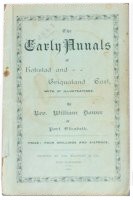 The Early Annals of Kokstad and East
Griqualand - Rev W Dower (b. 1837, d. 1919)
The Early Annals of Kokstad and East
Griqualand - Rev W Dower (b. 1837, d. 1919)
 This remarkably
frank book by the resident priest at Kokstad, Rev William Dower, gives a
fascinating insight into the Griqua people, their leadership and the settlers
who resided in East Griqualand.
This remarkably
frank book by the resident priest at Kokstad, Rev William Dower, gives a
fascinating insight into the Griqua people, their leadership and the settlers
who resided in East Griqualand.
The book caused quite a stir after its publication with letters to the local papers decrying it as inaccurate in its depiction of some of the central Griqua characters. Perhaps its greatest claim to fame is the inclusion of an original 1868 Griqua Pond note which was never issued. Carel Birkby the author of "Zulu Journey" visited Kokstad in 1935. On page 201 he says this about Dower's book, Thirty years ago Dower published a slim volume on his experiences among the Griquas. It is out of print now, and few copies exist, because the Griquas were so incensed at his true but uncomplimentary judgment on their character, and at his puckish jibes at them, that they destroyed every copy they could they could lay hands upon; and today the Kokstad library keeps its single copy under lock and key because otherwise some Griqua would probably rip it to pieces.
Less than 20 copies of this book exist today - mostly in museums and libraries like Killie Campbell in Durban (single copy), the Kokstad Library (single copy), the South African National Library in Pretoria (single copy) and British Library in London (single copy). Even major institutions like "The Library of Congress" (USA), with over 29 million books, only have Dower's 1978 reprint. The copy seen right above is one of three original copies held by the Balson Holdings Family Trust (all with the extremely rare bank note) which is conservatively valued with the book at over US$10,000 per copy. The book shown is signed by Dower's son and is in excellent condition for a book with a paper cover.
It has taken over 25 years of active searching to acquire the two copies in the collection. This book, like the extremely rare book by Campbell about Afrikaner, is actively sought by the trust.
No copies of the original work have been offered for sale on the Internet for many years (A few copies of the 1978 Killie Campbell reprint can be found).
The Balson Holdings Family Trust hold a soft and hard copy of this 1902 work in excellent condition. See this link for more on these books.
Critical comment on this work:An excellent book which provides a fascinating insight into the Griquas of East Griqualand. As you will see in the 1978 reprint by the Killie Campbell library, which includes copious notes, Dower's book caused quite a stir and reaction from the wider Griqua population. |

 COSMOGRAPHY IN FOUR BOOKS. CONTAINING
THE CHOREOGRAPHY AND HISTORY OF THE WHOLE WORLD: AND ALL THE PRINCIPAL KINGDOMS,
PROVINCES, SEAS, AND THE ISLES THEREOF, WITH AN ACCURATE AND APPROVED INDEX
OF ALL THE KINGDOMS, PROVINCES, COUNTRIES, INHABITANTS, PEOPLE, CITIES,
MOUNTAINS, RIVERS, SEAS, ISLANDS, FORTS, BAYS, CAPES, FORESTS, &C. OF
ANY REMARQUE IN THE WHOLE WORLD, London, 1682,
COSMOGRAPHY IN FOUR BOOKS. CONTAINING
THE CHOREOGRAPHY AND HISTORY OF THE WHOLE WORLD: AND ALL THE PRINCIPAL KINGDOMS,
PROVINCES, SEAS, AND THE ISLES THEREOF, WITH AN ACCURATE AND APPROVED INDEX
OF ALL THE KINGDOMS, PROVINCES, COUNTRIES, INHABITANTS, PEOPLE, CITIES,
MOUNTAINS, RIVERS, SEAS, ISLANDS, FORTS, BAYS, CAPES, FORESTS, &C. OF
ANY REMARQUE IN THE WHOLE WORLD, London, 1682,
Including: America, Florida, Virginia, Asia, Britain, Palestine, Arabia, Asia, Russia, Italy, Greece, France, Poland, The Alps, Germany, Spain, Africa, Ireland, Belgium, Denmark, Swethland, Hungary, Sclavonia, Dacia, Mount Haemus, Greece, Asia, Asia Minor, Cyprus, Syria, Mesopotamia, Mount Taurus, Turcomania, Iberia, Media, Persia, Tartaria, China, India, The Oriental Islands, Sumatra, Java, Borneo, Egypt, Barbary, Libya Interior, Terra Nigritarum, Aethiopia Superior, Aethiopia Inferior, Isles of Africk, Estotiland, Canada, Virginia, Florida, Nova Gallicia, Guatimala, Nova Hispania, Castella Avrea, Nova Granada, Peru, Chile, Paraguay, Brasil, Guiana, Paria, American Islands, Hispaniola, Cuba, Porto Rico, Monico, The Caribes, Granada, S. Vincent, Barbados, Mantinino, Deseada, Christophers, Sanc A Crux, Jamaica,
Four Volumes In One, HC, VeryGood, Folio (9-1/2"x13-3/4"), 943pp plus, Full leather, gilt stamping/ornament at spine, five ribs/six compartments. Pages clean, former owner's bookplate and name front endpaper, edgewear, corners bumped/furred, scuffing/soiling to leather, most cords mended, binding tight, crack to leather at spine.
The book contains the Rare Imprimatur Leaf
A copy in near perfect condition valued at about US$5,000 is in the Balson Holdings Family Trust collection see the images below.
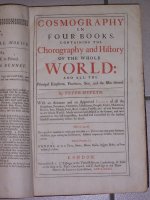 |
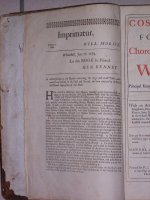 |
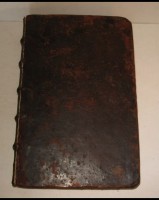 |
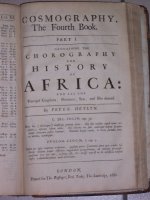 |
Critical comment on this work:A large book weighing over 11 pounds gives a fascinating insight into how the world and Africa was perceived at this time. See also the family trust's very rare original map of Africa by William Berry dated 1680 |
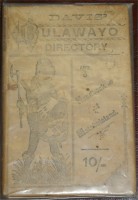
 THE original Bulawayo,
King Lobengula's royal kraal, which stood on the site of State House, was
occupied by the British South Africa Company on 4 November 1893. During the
opening months of 1894, Patrick Fletcher laid out a new Bulawayo on its present
site, and, by March, the first building stands were being offered for sale.
Bulawayo was declared a town on 1 June 1894.
THE original Bulawayo,
King Lobengula's royal kraal, which stood on the site of State House, was
occupied by the British South Africa Company on 4 November 1893. During the
opening months of 1894, Patrick Fletcher laid out a new Bulawayo on its present
site, and, by March, the first building stands were being offered for sale.
Bulawayo was declared a town on 1 June 1894.
Bulawayo's growth from that time can only be described as remarkable as all the building materials had to be brought several hundred miles by ox-wagon. By the end of 1895, development was sufficiently advanced to justify the production of a directory, and early 1896 saw the publication of The Directory of Bulawayo and Handbook of Matabeleland by Alexander Davis, of which this is an original.
It was the first directory to be issued in Rhodesia and as such is a collector's item. Very few of the originals remain. Alexander Davis was also founder and editor of The Bulawayo Sketch, the first illustrated newspaper to be published in the country. The scene is set in a number of feature articles which include the excellent first-hand picture, 'Lobengula and His Times' by James Dawson, a trader who was at Bulawayo before the occupation.
Of great interest to Bulawayans is the 'History of Bulawayo', a diary-of-events presentation of most fascinating information; and the invaluable list of names of Stand Owners and Occupiers.
Charm and character are imparted to the work by the informative advertisements, which exude the enterprise and enthusiasm of the pioneering period.
To say this book is 110 years old it in is surprisingly good condition. On the inside the pages & cover are beginning to separate through age and use. Otherwise it is without damage, stain etc and is protected by a home made plastic cover.
This rare original first edition hard copy of the directory is held by the Balson Holdings Family Trust.
Critical comment on this work:An extremely rare and sought after work which is the first ever directory of the region now known as Zimbabwe |
Travels in South Africa
(1815) - Rev
John Campbell

 The first edition book
covers John Campbell's first visit (1813) following the death of the Missionary
Society of London's lead man in South Africa. Campbell was sent out
to inspect the state of the missions and make recommendations for the future.
Campbell toured the country, meeting not only the natives, but the Boer settlers,
of whom he a had a very poor opinion. Near Graaf-Reinet, the party met the
celebrated traveller/explorer, Burchell and later on they journeyed through
the Snewburg and "Bushmen's Country" until they reached Klaar Water (home
of the Bastards/Griquas), from which place they pushed on for Lattakoo where
they made the acquaintance of the king, "Mateebe", and there is an interesting
account of the King and his people. Much information with regard to past
events involving the party of Dr. Cowan massacred years earlier and the countries
beyond Lattakoo was obtained from the King. (Reprint copy also held -
see below)
The first edition book
covers John Campbell's first visit (1813) following the death of the Missionary
Society of London's lead man in South Africa. Campbell was sent out
to inspect the state of the missions and make recommendations for the future.
Campbell toured the country, meeting not only the natives, but the Boer settlers,
of whom he a had a very poor opinion. Near Graaf-Reinet, the party met the
celebrated traveller/explorer, Burchell and later on they journeyed through
the Snewburg and "Bushmen's Country" until they reached Klaar Water (home
of the Bastards/Griquas), from which place they pushed on for Lattakoo where
they made the acquaintance of the king, "Mateebe", and there is an interesting
account of the King and his people. Much information with regard to past
events involving the party of Dr. Cowan massacred years earlier and the countries
beyond Lattakoo was obtained from the King. (Reprint copy also held -
see below)
It is in this book the immortal, but misleading words are penned: It was at this same meeting with the Bastards (Griquas), and probably more as a celebration of the name change that the idea of minting South Africa's first coinage was discussed on page 256:
"It was likewise resolved that as they had no circulating medium amongst them by which they could purchase any small article, such as knives, scissars (sic) etc, etc. supposing a shop to be established amongst them - which they were anxious there should be - they should apply to the (London) Missionary Society to get silver pieces of different value coined for them in England, which the Missionaries would take for their allowance from the Society, having the name of Griqua Town marked on them. It is probable that if this were adopted in a short time they would circulate amongst all the nations about, and be a great convenience".
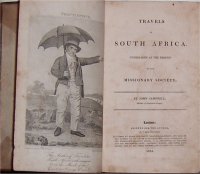 Balson also argues that the Griqua Town coins
that Campbell refers to in his 1815 book were eventually
minted as Pattern pieces in the 1870s -
like the 1890 Griqua Town Pattern "pennies"
and for the same reason - promoting the ability of the mint's capability
to the Zuid Afrikaansche Republiek before the first Kruger coins appeared
in 1892. Some of the logic is quite simple, not only were the Griquas unable
to count (they could not even write) but they had had no store to trade them
in Griqua Town. Campbell's lack of reference to them in his second book
Travels in S Africa, a second
journey (published 1822) when he re-visited the griquas
reveals the failure of his earlier diary notes. Finally, consider the relative
scarcity of all pieces "IIIII", 10, 1/4 and1/2 - pointing to a small trial
mintage not a mintage of coins to be used by a community...
after all it takes thirty to fifty 1/4 pieces to make up the change for a
"IIIII" or 10.
Balson also argues that the Griqua Town coins
that Campbell refers to in his 1815 book were eventually
minted as Pattern pieces in the 1870s -
like the 1890 Griqua Town Pattern "pennies"
and for the same reason - promoting the ability of the mint's capability
to the Zuid Afrikaansche Republiek before the first Kruger coins appeared
in 1892. Some of the logic is quite simple, not only were the Griquas unable
to count (they could not even write) but they had had no store to trade them
in Griqua Town. Campbell's lack of reference to them in his second book
Travels in S Africa, a second
journey (published 1822) when he re-visited the griquas
reveals the failure of his earlier diary notes. Finally, consider the relative
scarcity of all pieces "IIIII", 10, 1/4 and1/2 - pointing to a small trial
mintage not a mintage of coins to be used by a community...
after all it takes thirty to fifty 1/4 pieces to make up the change for a
"IIIII" or 10.
Image right: Frontpiece of the first edition book
A copy of this rare and valuable first edition book with original maps, in very good condition, with slight discolouration on some pages and damage to the outside rib is held in the Balson Holdings Family Trust collection.
Critical comment on this work:The comments on page 256 of Campbell's transcribed journals is at the very heart of the misconception that the Griqua Town coins (note in all Campbell's books he refers to "Griqua Town" as two words - not one as shown on the coins) were South Africa's first circulating currency. |

 Travels
in South Africa.. a second journey (published 1822) - Rev John
Campbell
Travels
in South Africa.. a second journey (published 1822) - Rev John
CampbellFull title: "Travels in South Africa, undertaken at the request of the London Missionary Society; being a narrative of a second journey in the interior of that country".
This very rare first edition (London) set of two books is an account of Campbell's travels among the various tribes of the northern Cape Colony and into Bechuanaland (Botswana), including the Griqua, Bushmen, Coranna and Tswana. There are two volumes, pp. viii,xii,322 + (iii),384,(i), 12 hand-coloured plates, folding colour map. Much of the trip was undertaken with the young Robert Moffat who was later stationed at a new missionary centre at Kuruman.
The book has its original contemporary full-leather, recased with original gilt backstrips laid on, new end-papers. The spine & hinges are rubbed and the map (commonly) repaired at the folds. This is an attractive set of the large paper edition (24cm tall) with just some foxing.
The Balson Holdings Family Trust holds this set of the two volumes in very good condition.
Critical comment on this work:It is Robert Moffat's less than flattering comments about John Campbell that make this book so intriguing. Moffat, who travelled with Campbell during his second trip, refers to Campbell's weakness for liquor and his foul mouth at these times. This side of Campbell, hidden in the books published by both missionaries is revealed in Moffat's letters published in the book Apprenticeship at Kuruman. Interestingly Campbell makes no reference to the "Griqua Town coins" in this book (see his book above) - an extraordinary oversight for a man who goes into so much detail about other aspects of Griqua life. |
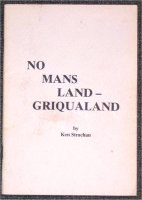 No Man's Land - Griqualand - Ken Strachan (1985)
No Man's Land - Griqualand - Ken Strachan (1985)
 This is an
extraordinarily rare work by Ken Strachan, Donald Strachan's grandson.
This is an
extraordinarily rare work by Ken Strachan, Donald Strachan's grandson.
Ken was the last Strachan to run the empire built by Donald and in this small 20 page soft cover book he recounts his memories and the stories he was told about the early days (1800s) of Nomansland.
The book outlines the early history of key white settlers in Nomansland including the Hulleys, Hancocks, Strachans, Callaways and Buttons.It covers the tragic trek by the Griquas from Phillipolis over the Ongeluksnek (Drakensberg) and into Nomansland.
The small book also covers the Griqua "rebellion" and the Gun War.
This is unique and extremely rare publication (c15 copies)
The Balson Holdings Family trust owns a copy signed by Ken Strachan.
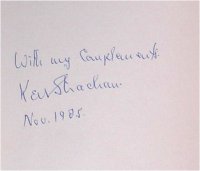 |
|
Signed by Ken Strachan |
Book has several changes hand written by author |
Critical comment on this work:Ken Strachan was the man who opened up the gates to this on-line work on the Strachan and Co tokens. A very humble man but one who spells out, factually, the early times of Nomansland under the influence of the "white" man. |

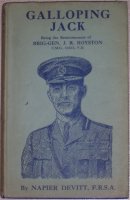 Galloping Jack - Napier Devitt (1937)
Galloping Jack - Napier Devitt (1937)
This 125 page hard covered book by Napier Devitt is about that extraordinary man Brigadier General John R Royston who in the 1880s owned the St Faiths store on the banks of the Umzimkulu River, a remote outpost situated between the town of Umzimkulu and the Indian Ocean.
The book covers in some detail the remarkable military history of John Royston who was known as "Galloping Jack" because of his valour on horseback which included riding six horses to their death (through being shot by the enemy) while encouraging his troops at the battle of Romani during the Palestinian Campaign during the first world war. "Galloping Jack" would mount a horse then ride out into the battlefield in full view of the enemy and in range of their guns while encouraging his troops to fight on.
Napier Devitt gathered the information from direct interviews with John Royston.
Our interest in the book is the old surviving copy of Royston's St Faith's
store coinage... a sixpence which can be seen in the image below. More on
this unique
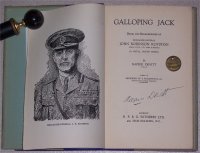 sixpence owned by the Balson Holdings Family Trust
can be seen at this link.
sixpence owned by the Balson Holdings Family Trust
can be seen at this link.
Here is an extract from Chapter Four (pp 37):
At that time Royston's headquarters were at his farm in the Ixopo district, "St Faith", and from here he set forward some of his trading ventures. Here, young as he was, he was consulted by the headman and that, and not infrequently visited by Government authorities who seemed to place some store by his influence among the tribes of north-west Natal.
The Balson Holdings Family Trust has a copy in excellent condition signed by Napier Devitt.
Critical comment on this work:An excellent and very rare book that just cannot be found today - even on the Internet |
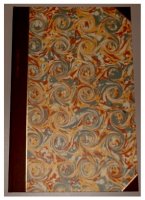
 This extremely rare book
gives "an account of the Cape of Good Hope and the Hottentotes". William
Rhyne, a Member of the Council of Justice to the Dutch East India Company,
originally wrote this work in Latin - the book held is the English translation
which was published at Scasshausen in Switzerland in 1704.
This extremely rare book
gives "an account of the Cape of Good Hope and the Hottentotes". William
Rhyne, a Member of the Council of Justice to the Dutch East India Company,
originally wrote this work in Latin - the book held is the English translation
which was published at Scasshausen in Switzerland in 1704.
The book gives a rare insight into the lives of the natives in the very early days of settlement by the Dutch in the Cape - and it is translated into contemporary English from an original report by Zevorzit written in 1671 - less than 20 years after van Riebeeck's party settled in Cape Town.
Extracts read: It's unknown hitherto, what Fort or People borders upon the country of the Hottentotes; for what some have related of the Negroes (commonly called Caffers) is founded upon heresay... The Hottentotes being very much sunburnt have generally a tawny skin tho' some of them have a tolerable white skin; but blackness is the greatest beauty among them, for the rest they either strew a certain Earth, of various colours, upon their heads, or mix the same with Suet, and so besmear their Hair and Faces, which they look upon as a singular Ornament; for there is a certain mountain here, which furnishes them with the materials for diverse colours. which if rightly managed, would turn to a good account. (The Hottentots were the foundation of the Griqua nation).
A very valuable find worth over US$1,000 (c 20 original copies in existence). Image of opening page at this link.
A copy in perfect condition is in the Balson Holdings Family Trust collection.
Critical comment on this work:A small book of just 20 pages but with some fascinating contemporary drawings and sketches. |
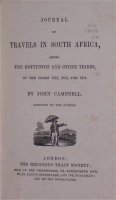
 This book is the key
piece in the jigsaw puzzle which clearly sinks the conception that the Griquas
used the Griqua Town coins in 1815- 1816.
This book is the key
piece in the jigsaw puzzle which clearly sinks the conception that the Griquas
used the Griqua Town coins in 1815- 1816.
Image right: Frontpiece of the abridged "Journal of Travels in South Africa" carries the same image and similar format as the earlier (1815) transcribed journal of his travels.
This 1834 work can only be found in damaged form on the Internet - it's date of publication and the author's personal input in what was published reflects a very different picture to that presented in his earlier work (linked above). Campbell avoids any reference to discussion with the Griquas about the minting of money. It is far rarer than Campbell's earlier two works of his travels to South Africa - yet once upon a time priced much cheaper.
NOTE: A transcript of the relevant pages of "Journal of Travel in South Africa" together with digital images of these pages can be seen at this link.
Two copies (one, two) of this extremely rare and valuable book, with slight discolouration on some pages is held in the Balson Holdings Family Trust collection.
Critical comment on this work:Campbell's omission in this work abridged by him of any reference to discussions with the Griquas about minting coins and his comment, in its place that Regular trades cannot be said yet to exist in Griqualand spells out the fantasy of what he wrote in the transcribed journals in his earlier work. |
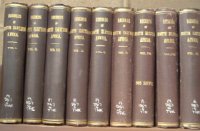 Records of south-eastern
Africa
Records of south-eastern
Africa
 This series of nine
books (the last book is a comprehensive cross reference) in original brown
cloth, with gilt titles by Theal . Theal, a historian, is recognised as the
authority on early South African history and is often referred to by authors
in research based historical books that followed.
This series of nine
books (the last book is a comprehensive cross reference) in original brown
cloth, with gilt titles by Theal . Theal, a historian, is recognised as the
authority on early South African history and is often referred to by authors
in research based historical books that followed.
The first edition of these books is extremely rare and the set is conservatively valued at over US$1,000.
The books are a detailed archival source on early records of exploration of the east coast of Africa, mainly by the Portuguese & British and including shipwrecks. The books were published over a number of years from 1898 to 1903 - the historical material ends in 1875. This set originates, acquired from ABC Books in Hilton, Natal, from the Wodehouse Public Library, Dordrecht, with white accession numbers on spines, library-stamps & accession numbers on end-papers, title-pages & odd other pages, covers slightly scarred & marked, some minor fish-moth damage to a few page margins.
This rare original complete series of nine books is held by the Balson
Holdings Family Trust.
Critical comment on this work:An invaluable resource used by historian over the last 100 years. |
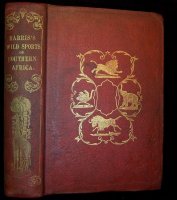 Wild Sports of Southern Africa - Captain William
Cornwallis Harris
Wild Sports of Southern Africa - Captain William
Cornwallis Harris

The first edition of this work was published in 1838 with the title "Narrative of an expedition into southern Africa", but it had only one illustration and a map; the second edition (John Murray, 1839) contained only 8 plates. This enlarged fifth edition is the most valuable and desirable version, as it is lavishly illustrated with 26 full-page lithographic handcoloured plates, including a folding map. One of the handcoloured plates in the book can be seen below right.
Tall royal 8vo, publisher’s original red cloth, upper cover with ornate border in blind and decorated with a central motif featuring four African animals, lower cover with border in blind, spine lettered and decorated in gilt featuring a large gilt giraffe, a.e.g.
This 359 page book has been skillfully and unobtrusively recased preserving the original cloth on the spine. An uncommonly well preserved copy with none of the expected foxing and only very minor age mellowing or wear to the scarce original cloth, particularly to the bottom corners.
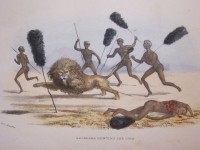 This
is the best edition and very rare in its original gilt decorated cloth.
Harris’ study goes far beyond simple game hunting and is a valuable
look into the Africa of the day. In addition to the studies of the wildlife,
he also gives us through both the text and the lithographic plates a look
at some of the indigenous peoples of the region. The plates themselves are
highly noteworthy. The images are dynamic and capture the movements, the
very nuances, of the subjects. In many cases these were among the earliest
glimpses Western peoples experienced of these fascinating animals and peoples.
The colour reproduction is excellent and the plates in this copy are particularly
clean and bright.
This
is the best edition and very rare in its original gilt decorated cloth.
Harris’ study goes far beyond simple game hunting and is a valuable
look into the Africa of the day. In addition to the studies of the wildlife,
he also gives us through both the text and the lithographic plates a look
at some of the indigenous peoples of the region. The plates themselves are
highly noteworthy. The images are dynamic and capture the movements, the
very nuances, of the subjects. In many cases these were among the earliest
glimpses Western peoples experienced of these fascinating animals and peoples.
The colour reproduction is excellent and the plates in this copy are particularly
clean and bright.
The Balson Holdings Family Trust holds a copy of this book in the
excellent condition described above
(value over US$1,500).
Critical comment on this work:One of the greatest 19th century works on African game and a true canon title of the genre. |
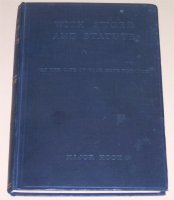 With Sword and Statute - Major D B Hook
1905
With Sword and Statute - Major D B Hook
1905
 Recollections of
a mounted officer on the Cape of Good Hope frontier, who came to South Africa
as a young boy. He served in most frontier wars and expeditions and was acting
chief magistrate in Griqualand East at various times and resident magistrate
in Herschel during the Boer war. 147 pages. Illus. with black/white photos
and line drawings.
Recollections of
a mounted officer on the Cape of Good Hope frontier, who came to South Africa
as a young boy. He served in most frontier wars and expeditions and was acting
chief magistrate in Griqualand East at various times and resident magistrate
in Herschel during the Boer war. 147 pages. Illus. with black/white photos
and line drawings.
Extracts: In the village of Umzimkulu I was warned to ingratiate myself with the ex-Griqua magistrate (Donald Strachan), who had also been a justice under British rule, and who was also a native chief in fact. I found that ex-justice and chief a charming Scotchman, full of fun and devilry. He could a tale unfold of border history if taken at the tide. He was a chief in right by native installation, and could speak the langauages. Since then he became a legislator in the Upper House of the Cape Parliament....
The possessions of one man alone "Jim Cole" quite a principality; milking sixty cows; thoroughbred horses, imported mixed with kaffir stock, miles and miles of farms along a shining river etc. But the Prince of Denmark was "George" (G C Brisley), of tracts in red traced upon a map, who dwelt up at the Pines. In easy days he would engineer and make a road; a stone in the way, he would bury it in the track. Charming eloquence for ever as his friend passed by. At last the rock died, and disappeared from view, like padda under ground. The tongue of George no more waxed eloquent, even to his best of friends; the soul of conversation dead.
This very rare book (unsigned) sells for over US$1,000
The copy held by the Balson Holdings Family Trust is in excellent condition and has been most unusually inscribed by the author and includes a lengthy letter and small photo from Hook's wife to a family friend, Mrs Charles Anthony, the recipient of the book.
Critical comment on this work:A fascinating book which looks into the life and times of the people in East Griqualand in the 1800s. |
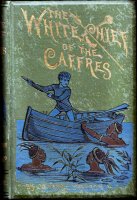
 An extremely rare
and hard to find 315 page book by Major-General Alfred W. Drayson, author
of "Sporting Scenes Amongst the Kaffirs of South Africa." A young
boy, Julius Peterson, was shipwrecked on the south-east coast of Africa
near the Umzimvubu river south of Natal which flows through the region
later occupied by the Griquas. Drayson and other shipwrecked white people
encountered the Caffres (Pondo or Amapondo natives - an off-shoot of the
Zulus to the north).
An extremely rare
and hard to find 315 page book by Major-General Alfred W. Drayson, author
of "Sporting Scenes Amongst the Kaffirs of South Africa." A young
boy, Julius Peterson, was shipwrecked on the south-east coast of Africa
near the Umzimvubu river south of Natal which flows through the region
later occupied by the Griquas. Drayson and other shipwrecked white people
encountered the Caffres (Pondo or Amapondo natives - an off-shoot of the
Zulus to the north).
As a young 10 year old boy he survived a Caffre attack shortly after the ship wreck in which all the other men were killed, and he was allowed to live and be brought up as a member of their tribe. Intriguing account of survival, bravery, becoming a chief, hunting all the wild game of Africa, fighting Zulus, being captured, narrow escapes, encounters with Bushmen and Boers. The "opera glasses" which brought things near and the gun which dispersed the Bushmen brought the young Drayson great esteem among the Pondo people long before the first whites settled what was later to become East Griqualand.
Although a story Drayson's book parallels what actually did happen in that region in the 1700s - with whites shipwrecked on the coast at Umzimvubu being taken into the local Amapondo tribe and coloured children resulting from the union of white women and their native captors. The book gives an excellent account of the region and how the harbour at Durban looked before being settled by the white man.
The book has a deep green cloth bevelled hardback with pictorial cover with bright gilt title. Spine is also decorated with Zulu warrior and bright gilt title. Tissue-guarded frontispiece and numerous wonderful illustrations throughout. This rare book is in very good to excellent condition, with clean pages, no writing, end papers have some foxing, a little wear to cover print.
This rare first edition 1887 edition of this book is held by the Balson Holdings Family Trust.
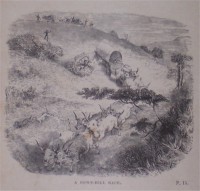 |
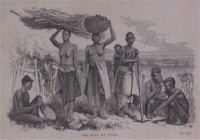 |
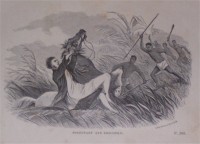 |
Critical comment on this work:An extremely rare novel which gives a graphic insight into a young white man's earliest contact with the Amapondo and Zulu people in the region of southern Natal/East Griqualand. Easy reading and well told. |
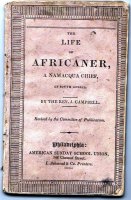 The Life Of Africaner, A Namacqua Chief, Of South Africa
The Life Of Africaner, A Namacqua Chief, Of South Africa
by the Rev. J. Campbell
(1832)
Published in Philadelphia by the American Sunday School Union. (Soft covered 1832 edition seen right)
Softcover/Hardcover. Small, 13cm by 8cm. Pages vary on editions.
The Juvenile Cabinet of Publications with this issue concerning the Hottentot brigand, Jager Africaner, who attacked Boers and other natives before converting to Christianity (26 pages). There is an additional 9 page tract entitled "Happy Death of a Madagascar Youth". It is illustrated with wood engravings.
Three copies of this extremely rare book, one with a soft (1832) and two with a hard cover (1833 and 1837), all with slight discolouration on some pages are held in the Balson Holdings Family Trust collection. The purchase of multiple copies of this book, like Dower, is made by the trust because of its extreme, but unrecognised, rarity. You cannot buy these books anywhere today and just a handful remain in existence.
No copes remain for sale on the Internet.
More on this book at this link.
| Back of extremely rare 1832 Soft covered edition |
|
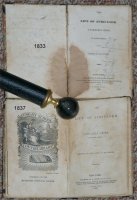 |
Critical comment on this work:A fascinating but somewhat biased insight by Campbell into the life of this reformed bandit |
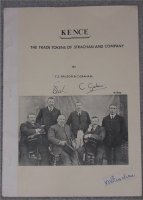 Kence, the trade tokens of
Strachan & Co -
Kence, the trade tokens of
Strachan & Co -
 The extremely rare
30 page Africana book "Kence" the trade
tokens of Strachan and Company by C S Balson and C Graham
(1978) which is partly transcribed at the links above can be found in
some of the world's major libraries like the Afrikaner Library in Johannesburg.
This book received the solid endorsement of Ken Strachan, grandson of Donald
Strachan (See page one, page
two of his letter in which he orders 30 copies).
The extremely rare
30 page Africana book "Kence" the trade
tokens of Strachan and Company by C S Balson and C Graham
(1978) which is partly transcribed at the links above can be found in
some of the world's major libraries like the Afrikaner Library in Johannesburg.
This book received the solid endorsement of Ken Strachan, grandson of Donald
Strachan (See page one, page
two of his letter in which he orders 30 copies).
Originally 1,000 copies were printed - 850 were burnt in a fire leaving just 150 copies the unsigned copies are worth US$250. Many photocopies of this work are in existence today.
The thumbnail image right is of one of only ten signed copies of the book "Kence, the trade tokens of Strachan and Co". The book is signed by the authors Balson and Graham and endorsed under the Strachan and Co company stamp by Ken Strachan in the bottom right corner.
The book shown here forms part of the Balson Holdings
Family Trust collection which owns twenty other copies of the original 1978
publication.
Critical comment on this work:The first work of its kind detailing the fascinating history of the Strachan family and their coinage, the Strachan and Co token coins. A very rare work that has not been seen on auction for many, many years. |
 One of a handful
of the first and only edition published in 1966 by
the Africana Museum in South Africa. It is a bulky book weighing over 2kg
and entitled "Tokens of Southern Africa. A Catalogue Based on the
Collection in the Africana Museum". The 233 page book details
the technical information of hundreds of tokens catalogued from the Africana
Museum and Colonel J L Knobel's collections. The tokens are listed
by South African state and include neighbouring states like Rhodesia.
One of a handful
of the first and only edition published in 1966 by
the Africana Museum in South Africa. It is a bulky book weighing over 2kg
and entitled "Tokens of Southern Africa. A Catalogue Based on the
Collection in the Africana Museum". The 233 page book details
the technical information of hundreds of tokens catalogued from the Africana
Museum and Colonel J L Knobel's collections. The tokens are listed
by South African state and include neighbouring states like Rhodesia.
The Balson Holdings Family Trust owns an extremely rare hard copy edition of this work in near mint condition with original binding of blue cloth with gilt edges. It is worth about US$1,000. Most copies of the book found today are reprints made in the 1960s softbound in yellow paper covers and bound by staples.
Critical comment on this work:An excellent and comprehensive work by an accomplished librarian. The work details many of the South African tokens held in the Africana Museum and once held by Col Knobel. |